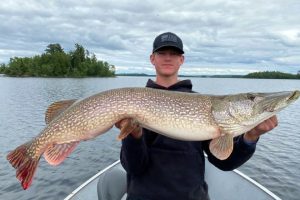
A Cottage Grove man raises — and tracks — monarch butterflies from eggs on milkweed leaves to flights to Mexico
As July sunlight pokes through the trees, a butterfly egg rests gently in Wojciech Poreba’s palm as he sifts through milkweed leaves at Hamlet Park in Cottage Grove.
At age 25, Poreba has four years of experience raising monarch butterflies. There is no place for impatience, he said, and being delicate is key for success.
In Poland, where he was born before arriving in the U.S. at 15 with his mother and stepfather, there are no monarchs. Instead he raised spiders and other types of butterflies, like swallowtails. Poreba currently has a giant white knee tarantula and a young sapphire tarantula, along with monarch and swallowtail caterpillars, among his collection in his room.
“I always loved insects. I have always just enjoyed watching or raising them since I was a kid,” said Poreba.
The first he learned about monarchs was through television nature shows, then he gained more knowledge through the Boy Scouts. After doing research, he decided it was time to raise them on his own.
Wojciech Poreba inspects milkweed at Hamlet Park in Cottage Grove while looking for monarch butterfly eggs Wednesday afternoon, Aug. 7, 2024. (Devanie Andre / Pioneer Press)
Raising and releasing
In 2020, Poreba raised 60 monarchs given to him by his sister from the Minnesota State Fair. Last year, after keeping track of butterflies on a spreadsheet, he raised 999 monarchs. He hopes to raise 3,000 by the end of this summer.
With 600 released in early July, Poreba has hundreds more metamorphizing in his bedroom in Cottage Grove.
Poreba collects monarch eggs from milkweed plants along parks and highways that use pesticides or are being cut down. He carefully looks under the leaves of milkweed plants — the only plant that monarch butterflies reproduce on — for white eggs the size of a pencil tip.
In places where he sees monarchs thriving, he leaves the eggs alone.
Wojciech Poreba holds one of approximately 60 monarch caterpillars that he is currently raising at his Cottage Grove home on Wednesday, Aug. 7, 2024. (Devanie Andre / Pioneer Press)
“When you raise them inside, you give them a much higher chance of survival because just 10 percent or less survive to adulthood,” said Poreba. “The number one important thing is to have milkweeds because that is the only plant that the monarch butterflies will reproduce on.”
When he collects eggs, he plucks the leaf off and places it into a bucket with other milkweed leaves. After thoroughly checking the plant, Poreba brings the eggs home to raise.
Caterpillars big and small
Monarch caterpillars big and small crawl along a row of potted milkweed plants by his bedroom window, littering the sill with dried leaves. Along the ledge are replicas of spiders and butterflies.
Related Articles
Skywatch: Celestial eagle soars high in the sky
Lake Nokomis beaches remain closed after sanitary sewer spill; here are other swimming options
Woodbury Days festival to feature fireworks show, parade
MN State Fair: Here’s what you need to know about hours, deals, parking and more
Lake Nokomis beaches closed after sewer overflow
On the wall hangs a poster displaying different types of bees. Above a neatly made bed is an old chrysalis, with a new one hanging beside the bedframe. On top of a large drawer are spreadsheets, tagging stickers and dried milkweed leaves holding new eggs. Next to the eggs is an old Kemps ice cream container with a swallowtail caterpillar, next to a small tarantula habitat.
The eggs take about a week to hatch, and off it goes to eat the milkweed leaves. As the larva grows into a striped caterpillar, Poreba moves it to a milkweed plant by his windowsill.
There, the caterpillars are free to roam and eat until they grow to full size, which takes another two weeks.
Poreba lets the caterpillars climb to the top of his window frame as they prepare to form a chrysalis. He likes to keep a close eye on the caterpillars as they decorate the window frame with green cocoons. As the chrysalises form and set, metamorphosis starts — a process that turns the caterpillars into colorful monarch butterflies.
Tagging stickers
Finally, after two to three weeks, the striped caterpillar emerges as a orange-winged butterfly. Once the monarch’s wings are fully dried, Poreba carefully places tagging stickers — just a few centimeters in size — on its wing. The stickers are used to track the butterflies as they travel to Mexico. Eastern monarchs make the journey to Mexico, while western ones travel to coastal California.
Poreba has been doing this process for four years in Minnesota with tags from Monarch Watch, a research, education and monarch butterfly tracking program through the University of Kansas.
Each fall, the group distributes more than a quarter of a million tags to volunteers across North America. The volunteers capture monarchs throughout the migration season, record the tag code, tag date, gender of the butterfly and geographic location, then tag and release them. At the end of the tagging season, this information is submitted to Monarch Watch for their research.
Last year, Poreba became a Boy Scouts Cubmaster and now helps teach young people about insects. By helping Minnesotans raise and learn more about monarch butterflies and their importance to the ecosystem, he hopes that others will be encouraged to plant butterfly gardens and protect natural habitats for them.
Wojciech Poreba observes his milkweed plants that house and feed approximately 60 caterpillars on a windowsill at his home in Cottage Grove on Wednesday, Aug. 7, 2024. (Devanie Andre / Pioneer Press)
“If you don’t have experience raising monarch butterflies, you can just simply plant one milkweed for them. That is extremely helpful for them already and you can learn what they look like so that you know not to pull out milkweeds or spray them with pesticides,” said Poreba.
He hopes to raise enough butterflies to create a public release event in the fall. He said he’d like more people to appreciate them and other insects.
“I would say not to be scared of insects. Not all insects are harmful. Many insects are extremely beneficial for our gardens. Without bees, we wouldn’t be here. Bees are (the) number one insects that pollinate flowers to create forests.”
More about monarchs
Monarch butterflies have bright orange-red wings with black veins that are speckled with white spots along the edges. Monarchs are known to migrate across North America and Canada to Mexico, then return to their homes to reproduce and start the cycle again.
The monarch butterfly is the only butterfly known to make a two-way migration, according to the U.S. Forest Service website.
Butterflies are among many pollinators in nature and though they are not the most efficient pollinators, they are recognizable and well-known. Pollinators come in many shapes and sizes, and are beneficial for the health and reproduction of flowering plants.
Wojciech Poreba finds a monarch butterfly egg on a milkweed plant at Hamlet Park in Cottage Grove on Wednesday, Aug. 7, 2024. (Devanie Andre / Pioneer Press)
In December 2020, the U.S. Fish and Wildlife Service declared monarchs to be “warranted and precluded,” which put the monarch butterfly on the candidate list for endangered species due to higher priority listings. The list is where the status of a species is held under review each year until it is no longer a candidate.
On July 21, 2022, the International Union for Conservation of Nature announced that monarch butterflies have entered the IUCN Red List of Threatened Species as endangered. This is the first time the butterfly was officially declared at risk of extinction.
Milkweeds are vital to the reproduction of monarch butterflies since it is the only food source for larvae. By destroying habitats with milkweed plants, either from pesticides or cutting down natural terrain, the reproduction rates of monarchs decline.
In order to efficiently raise monarchs, it’s important to do research on what they are and how to take care of them. Monarch Joint Venture, a 501(c)(3) organization, is one of many that can provide resources and ways to help monarchs.
Washington County’s efforts recognized
Meanwhile, this summer Washington County’s Public Works Department received two national awards for its efforts to protect monarch butterfly habitat.
The Biggest Adopter Award is given to partners with the most acres using adopted conservation measures. And the Highflyer Award is given to those with the highest percentage of adopted acres above a 2023 target.
The awards were presented to county staff by the Monarch Candidate Conservation Agreement with Assurances Program, a voluntary program working to protect and grow monarch butterfly habitat.
Related Articles
Over a century and four generations later, Stillwater Motors officially changes hands
Taylor Swiffer? Sweep Dogg? Help name Woodbury’s new street sweeper
Stillwater Lift Bridge to close Wednesday for electrical work
South Washington County Schools board votes to give themselves a raise
Woodbury: Alamo Drafthouse to reopen Tuesday


